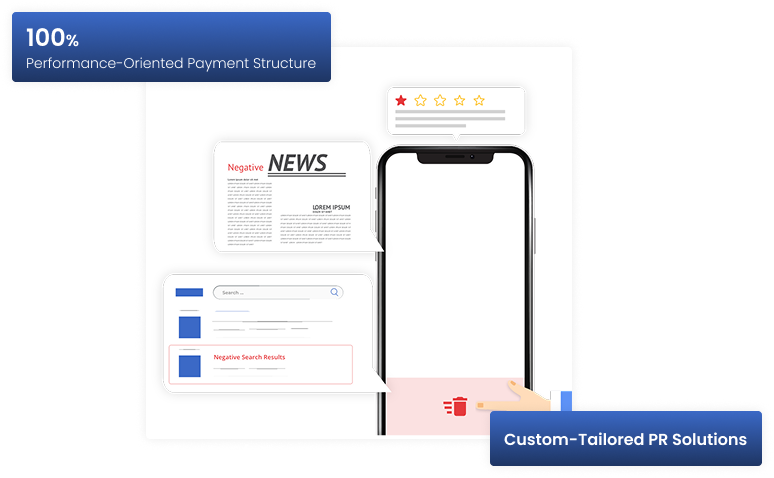
How to Improve Your Online Reputation
The digital world demands not only your online presence but a reputation that benefits you. Therefore, you need to actively manage your digital footprint, control the narrative, and ensure that your online presence aligns with the image you want to project. Whether you’re a business, a professional, or even a content creator, how people perceive you online directly impacts trust, credibility, and opportunities.
But reputation can shift quickly, sometimes in a direction you don’t intend. This article will help you improve and build an online presence that earns trust and stands the test of time.
Table of Contents
Establishing a Strong Foundation
1. Establishing a Strong Foundation
You can’t fix what you haven’t found. So, before anything else, audit your online presence to develop a targeted reputation management strategy instead of blindly making changes that may not yield results. Once you’ve identified the gaps, the next step is simple: Close them. And that starts with the basics.
A dormant profile signals neglect, making your brand seem irrelevant or even untrustworthy. That’s why consistent posting isn’t optional, it’s foundational. A well-planned content calendar keeps you visible without overwhelming your audience. But visibility alone isn’t enough, you also need to show up, respond to comments, answer DMs, and acknowledge mentions because when people feel heard, trust builds.
Moreover, each platform serves a different tone, pace, and purpose, and your approach should reflect that. Simply copying and pasting the same content across all channels dulls your brand voice and misses the opportunity to connect in platform-specific ways. Customize your content, and go above the obvious.
Beyond being active, your branding must be consistent. In terms of visuals, your logo, color schemes, and visual identity should be uniform across all platforms, so no matter where a customer finds you, they instantly recognize your brand. Your tone and messaging should also stay true across every channel. A playful, casual tone on social media but a stiff, overly corporate voice on your website creates mixed signals. Instead, let your brand voice carry through, from social to web, from blog post to support email, so customers always know what to expect.
Most importantly, your values and promises need to show up in your customer experience. If you claim to be customer-first, prove it in every interaction. A complaint that starts on social and continues over email should feel like a smooth, ongoing conversation, not a disconnected handoff. Make sure every interaction reflects the same level of care and professionalism. Remember, inconsistencies create friction, and friction leads to distrust. To succeed in reputation management, you need to be active, intentional, ensuring every interaction reinforces your identity and credibility.
2. Humanizing Your Brand: Be Relatable, Not Robotic
When people feel like they’re interacting with a real person rather than a scripted bot, they’re more likely to engage, forgive mistakes, and become repeat customers. Look at Duolingo’s TikTok strategy; they will hop on every trend possible, and their casual, fun, and sometimes borderline-chaotic tone makes them one of the most followed brands on the platform. Why? Because they say what their audience wants to hear, and people connect with it.

No brand is perfect yes, not even yours. Mistakes will happen; they have to happen. But the way you handle mistakes will either build trust or destroy it. So, if you mess up, don’t hide behind vague statements. Own it, fix it, and move forward. KFC’s apology is a great example; when they ran out of chicken in the UK. Instead of issuing a dull, legal-sounding statement, they released a full-page ad featuring an empty bucket with the letters rearranged to spell “FCK.” Clever and funny! The ad acknowledged the issue with humor and transparency, and customers not only tolerated but also stayed engaged.
And let’s say your creative team doesn’t work great under pressure, your option would be to simply admit and own it. This, paired with real action, can turn any PR disaster into a moment of regained trust. Be specific and show action. Instead of “We apologize for the delay,” you can go for “You’re right; we dropped the ball. Our shipping team is working on a fix, and we’ll reach out with a solution shortly.” That’s just one of the many examples you can apply, depending on the context of your brand. The end goal is to reassure your audience that you care!
People should feel like they know your brand, not just your product. In a world where social media often feels staged, authenticity stands out. Customers are far more likely to trust a brand when they see the real people behind it. Sharing behind-the-scenes moments, team highlights, or even the creative process can make your brand more relatable. Humor, when done right, is another great tool to make your brand memorable and approachable. But it has to feel natural, not forced. Lean into humor that aligns with your brand’s personality and resonates with your audience.
At the end of the day, people connect with people. Words you say to them can be forgotten, but not how you make them feel. So, make them feel seen, heard, and valuable by humanizing your brand.
3. Strengthening Your Social & Online Presence
Once the improving part is done, the next step should be strengthening your online presence. Start by tracking brand mentions across platforms, including those of your competitors. Tools like Brand24 and Mention give you real-time insights into what’s being said, where, and by whom; catch untagged mentions, spot emerging sentiment, and join the conversation before it becomes a problem. If users are expressing frustration with a competitor, that’s a window of opportunity to position your brand as the better solution without being overtly self-promotional. It’s simple: if your competition is getting more attention, you’re already behind.
Capitalize on industry-relevant trends before they peak. Use platforms like Twitter Advanced Search, Reddit, and TikTok to spot viral discussions early. Then, inject your brand’s perspective with speed and relevance. Timeliness, paired with clarity, positions your brand as a proactive voice, and that matters.
Your profile visibility is equally important. Optimize your bios with SEO-driven keywords so your brand appears where it matters most: at the top of search results. On platforms like Instagram, LinkedIn, and YouTube, pin high-impact comments that drive conversations, redirect attention to key resources, or clarify narratives before misinformation takes hold.
However, you cannot rely on generic content, creativity is a must. Use captions and posts that have searchable phrases or keywords to increase discoverability without compromising your voice. Besides, a refined hashtag puts your brand in front of the right audience faster.
4. Owning the Narrative Before Others Do
A strong reputation isn’t left to chance; it’s carefully shaped with strategy and precision. If you don’t control the narrative, search engines, competitors, and online chatter will shape it for you. The thing is, once misleading content takes root, reversing the damage is significantly harder than preventing it in the first place.
Start with Google; when users type your brand name, autocomplete suggestions set their expectations before they even hit enter. If terms like “scam” or “complaints” show up, it’s a red flag but also a fixable one. Instead of ignoring the issue, shift the conversation by driving optimizing demand for positive alternatives. Publish in-depth customer testimonials and expert-backed insights that reinforce your credibility. The more engagement your positive content receives, the more it pushes negative associations out of prominence.
Beyond search results, your social and digital presence must be in check. Use social listening tools like Brandwatch, Mention, or Google Alerts to monitor brand mentions, industry conversations, and competitor activity in real time. When criticism arises, your response can either build trust or fuel doubts. Thus, avoid dismissive replies as they signal indifference. Instead, show transparency and action: “We understand the concern and are actively working on a solution. Expect an update soon.” If the issue stems from a real mistake, own it before third parties capitalize on it or your customers get the chance to talk about it.
Owning the narrative doesn’t mean silencing criticism; it’s about ensuring the right story is told on your terms.
Individual Reputation Management Services
We’re here to help you take control and ensure your online presence reflects the real you.

5. Developing an Online Review Strategy
People rely on social proof, and it’s your job to make it easy to find. For that, you need to engineer your review strategy.

Ask at the Right Time
Timing makes all the difference. The best time to ask for a review is right after a great experience, when the interaction is still fresh and enthusiasm is high. If you have a product-based business, send an automated review request a few days after delivery. For services, ask right after a positive exchange or successful outcome. If a client compliments your work, that’s your green light. To make it easy, drop a direct link to Google, Trustpilot, or wherever you want the review. Keep in mind, though, that different customers respond to different approaches, so customize the strategy when needed.
Offer Ethical Incentives
Encourage affirming feedback without crossing lines. A monthly giveaway is a simple, compliant way to nudge people toward action. Like, everyone who leaves a review gets a chance to win something — recognition works too. Then, highlight the best reviews; it not only validates your brand but shows customers their voice matters.
Catch Complaints Before They Go Public
Not every unhappy customer heads straight to Google or Yelp unless you give them no alternative. A simple post-purchase survey or feedback form can surface problems early. If someone flags a bad experience, follow up directly and resolve it behind the scenes. Quick, personal responses through email or live chat can defuse tension and keep your reputation intact.
Turn Competitor Feedback to Your Advantage
Your competitors’ reviews can tell you exactly what to highlight. If people complain about their support, promote your fast, helpful service. If they love a feature, show how yours goes one step further. Use their pain points as your proof points and position your brand as the better option.
Shape the story: Don’t Just React
Reviews are the part of the story you’re telling. From how you ask to how you respond, to how you spotlight feedback — everything should align with the brand you’re building. In essence, shaping a reputation that reflects who you are and why you’re better.
Reviews can be your greatest strength or your biggest liability, so curate strategically.
However, no matter how much effort you put into managing your reputation, crises are bound to happen. Take time to assess the situation before issuing a response. Provide a solution where possible, and make it clear that customer concerns are taken seriously. If the issue involves misinformation, correct it with factual content.
Your online reputation is your key asset, and it certainly isn’t a one-time fix. It’s a continuous, strategic process that demands attention and expertise. Maximatic Media can take the burden off your shoulders to guide your brand through every step of the journey, enhancing your image and protecting what matters most. Because with the right tools, insights, approach, and connections, your brand can be shaped as an authority in your industry that remains trusted, credible, and influential.
Get in touch
Got a query that Nikolas Lemmel can help you with?
Check out other Blogs

How to Deindex a Page from Google to Manage Negative Content
Have you ever searched your name or business online and found pages you’d rath…

How to Get Featured in Forbes
Founded in 1917 by Bertie Charles, Forbes is one of the most prestigious business magaz…

How to Remove Suggestions on Google
Accounting for 95.32% of the global mobile search engine market and similar desktop s…

